
Walkers for Elderly
Recommendations, How-to and Buying Guides
Walkers for elderly come in a variety of different styles - some with wheels and others without.
It's important to know the difference between the styles as they are each designed for specific purposes and abilities.
Aging can affect a senior's ability to safely move around their home and community.
There can be a decrease of balance, strength, vision as well as other issues that all affect ones ability to walk safely - either inside or outside the home.
Since there are different levels of support and assistance needed, there are different styles of walkers for elderly.
There are also a wide variety of companies making walkers for elderly and each has their own selling features.
Hemi Walker
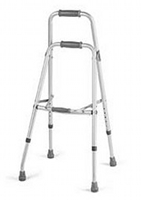
A hemi walker is designed for elderly who need the functionality of a quad cane (one handed use) but need additional support.
It looks similar to a folding walker but is held in one hand like a cane.
These types of walkers for elderly are commonly used by elderly who have partial or full paralysis of one side of their body (hemiplegia due to a stroke).
Who Should Use a Hemi Walker?
Elderly who do not have full use of one side of their upper body making it difficult to use a walker because they cannot hold on with both hands.
In addition to a stroke, elderly who have had a fracture or surgery to an arm, wrist, shoulder or collarbone may use a hemi walker while they recover.
Who Should NOT Use a Hemi Walker?
Elderly who do not have enough balance to use a hemi walker safely. They would be better off using a wheelchair.
Elderly who do not need the additional support a hemi walker provides and are able to use a quad cane instead. Quad canes are easier to use as they are not as large.
How to Use a Hemi Walker
Hemi walkers take time and practice to use safely and efficiently.
Proper use:
- Adjust to proper height - See below for how to fit walker.
- Hold hemi walker In the hand opposite of affected side
- Advance walker - Start with small steps
- Lead with affected leg - Opposite leg of hand holding walker
- Follow with "good" leg - Taking a small step to bring it in line with other foot
- Be patient - Practice and have someone close by for balance if new or concerned about falling
Recommended Features
A good hemi walker will:
- Be lightweight - Is easier to use.
- Be height adjustable - To adjust for fit and comfort.
- Be foldable - So it can be easily stored in a car.
- Be sturdy and stable - To ensure safe use.
How Much Does a Hemi Walker Cost?
A hemi walker costs $50-100 depending on quality.
For More Information: Hemi Walker
Folding Walker (Also called: Standard)
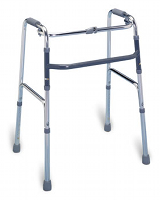
Folding walkers are the simplest walkers for elderly. As you can see in the photo, this walker has two handles, four legs and no wheels. It is height adjustable (although can only adjust 5-10" per size).
They usually fold in half so they can be easily stored in the trunk of a car while traveling or in a closet when not in use.
Who Should Use a Folding Walker?
Elderly who need to place significant weight onto the walker. For example, elderly who cannot place their full weight on one or both of their legs because they had a hip replacement or knee surgery.
Elderly who need a walker but their other walker does not fit into the space. For example, elderly may not be able to get their rollator walker in the bathroom but needs some support while they are in there. A folding walker could be placed at the entrance of the bathroom and used just for this task.
Who Should NOT Use a Folding Walker?
It offers the most support but the individual must pick the walker up every two steps which is cumbersome. So, these types of walkers of elderly are not appropriate for elderly who just need some balance support and do not have any weight restrictions on one of their legs. In that case they would be better off with wheeled walkers for elderly (see below).
How to Use a Folding Walker
- Adjust to proper height - See below for how to fit walker for elderly
- Get in position - Place both hands on the handles
- Stand upright - This will likely place the users feet in line with the rear legs
- Advance walker - How far depends on the senior's height but do not put the walker too far in front (about 1 regular step)
- Walk into the walker - If the senior has a sore leg/foot or a leg that the doctor does not want them to put weight onto, then advance this leg first followed quickly by the other. This will be a hopping motion if the doctor does not want the senior to place any weight on that foot/leg.
- Small steps - Take small steps especially while turning around - such as when getting into a chair.
- Foot position - Do not get too close to the front of the walker. Make sure the senior's heels do not go past the rear legs of the walker.
Recommended Features
- Lightweight - Since the user needs to pick it up every two steps, it's important to buy a model that is lightweight. That being said, if the user is a rather large individual, you will need to make sure it is strong enough to carry their weight.
- Sturdy/Stable - Make sure the walker legs are sturdy and even. Some poorly made walkers for elderly have legs that are not exactly even so that it rocks. This makes it difficult to use and is a safety risk.
- Foldable - Make sure it can fold in half so that it is easy to store in the trunk of a car, etc.
Accessories
- Front wheels - Most models can be made into a two wheel walker by replacing the standard legs in the front to ones with wheels. It is recommended to then replace the rear legs with ones with skids or skis so that it slides on the ground easier.
- Oxygen tank holders - This can be difficult to manage as it increases the weight of the walker making it more difficult to move.
- Trays/Bags - The bags are more useful than the trays as items can easily fall off the tray and are more likely to stay in the bag. These can be excellent additions to a folding walker as both hands are in use while using the walker (ie. no free hand to carry items around house).
- Foam handles - They make the walker more comfortable - especially for those with arthritis - as the user will be placing a fair amount of weight onto the handles while using it.
How Much Does a Folding Walker Cost?
A folding walker will cost $50-100. It is one of the more affordable types of walkers for elderly.
For More Information: Folding Walker
Front Wheel Walker (Also called: Two Wheel or 2WW)
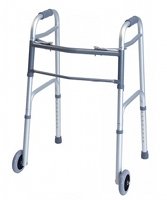
Front wheel or two wheel walkers for elderly are much like standard walkers but with wheels on the front and often have skids/skis on the rear legs. This allows it to more easily slide on the ground.
Similar to a folding walker, they can usually fold in half to store in the trunk of a car, etc.
Who Should Use a Front Wheel Walker?
Elderly who need to place some weight onto the walker (but not all). It is also light weight, easy to transport and slides across the floor. Some people who have rollator walkers for elderly also have front wheel walkers to take with them when they travel as they are foldable, lightweight and can more easily fit in the trunk of a car.
Who Should NOT Use a Front Wheel Walker?
Elderly who need to place most of their weight on the walker - for example, if the doctor does not want them to place any weight on an injured foot/leg or post hip surgery. Although they are lighter than rollator walkers for elderly, they do not work well outside.
How to Use a Front Wheel Walker
- Adjust to proper height - See below for how to fit walker.
- Get in position - Place both hands on the handles.
- Stand upright - This will likely place the users toes/midfoot in line with the rear legs.
- Advance walker - Push the walker in front of you so that you are walking within the walker.
- Walk into the walker - If the senior has a sore leg/foot or a leg that the doctor does not want them to put full weight through, then advance this leg first followed quickly by the other.
- Small steps - Take small steps especially while turning around - for example to get into a chair.
- No lifting needed - The advantage of these types of walkers for elderly over standard walkers is that the senior does not need to pick it up to walk.
Recommended Features
- Large fixed - Larger wheels roll better over uneven ground. Some front wheel walkers for elderly have swivelling wheels (like a shopping cart) but they are not as stable as the fixed wheels.
- Lightweight - Light enough so the user can easily manoeuvre it as well as pick it up to place in car trunk, etc. That being said, if the user is a rather large individual, they will need to make sure it is strong enough to carry their weight.
- Sturdy - Make sure the walker legs are sturdy and even. Some poorly made walkers have legs that are not exactly even so that it rocks. This makes it difficult to use and is a safety risk.
- Foldable - Make sure it can fold in half so that it is easy to take in the trunk of a car, etc.
Accessories
- Skis/Skids/Tennis Balls - These allow the rear legs to slide more easily on the ground than the regular rubber tips.
- Oxygen tank holders - This can be difficult to manage as it increases the weight of the walker making it more difficult to move.
- Trays/Bags - The bags are more useful than the trays as items can easily fall off the tray and are more likely to stay in the bag. These can be excellent additions to a folding walker as both hands are in use while using the walker (ie. no free hand to carry items around house).
- Foam handles - They make walkers for elderly more comfortable - especially for those with arthritis - as the user will be placing a fair amount of weight onto the handles while using it.
For more information: Walker Accessories
How Much Does a Front Wheel Walker Cost?
A front wheel walker will cost $50-100.
Rollator Walker (Also called: 4 Wheel or 4WW)
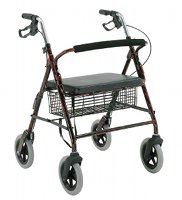
Rollators (also called 4 wheel walkers) are just that - walkers for elderly with four wheels, brakes, a seat and a basket/bag. They work well both indoors and outdoors - especially models with large wheels that easily roll over uneven ground and carpet.
Who Should Use a Rollator?
Elderly who need a walker for balance but do not need to put much weight onto it. It is also beneficial for seniors who need a seat to rest, want to carry items and want the security of having something to hold onto when walking. Most versions are also foldable and can fit in the trunk of a car. The styles with larger wheels are recommended as they roll easier on uneven ground and are usually more stable.
Who Should NOT Use A Rollator?
Elderly who have a sore foot/leg/hip and the doctor does not want them to place weight onto it (ex. post hip surgery). This is usually temporary and the senior can progress to a rollator at a later date.
Elderly with significant balance, strength and endurance issues. They may be safer using a two wheel walker or wheelchair - depending on what is causing their difficulty walking.
Elderly with advanced Parkinson's Disease may benefit from U-Step walkers for elderly.
How to Use a Rollator
- Adjust to proper height - see below for how to fit a walker
- Lock brakes - I recommend locking the brakes anytime elderly are sitting down on the walker's seat or getting up/down from a chair/bed/couch with the walker in front of them. On most rollator walkers with seats, the senior can lock the brakes by pressing the brake levers down till they lock in place. This ensures the walker will not roll away from the user.
- Get in position - Place both hands on the handles.
- Stand upright - This will likely place the users toes/midfoot in line with the rear wheels
- Walk normally - Try to stay in a normal upright walking position and not to hunch over or get the walker to far ahead.
- Small steps - Take small steps especially while turning around - for example to turn around to get into a chair.
- Using seat - Find level ground, lock brakes, turn around and sit down. Do not sit down to hard as brakes are built for light hold only.
Recommended Features
- Large wheels - Larger wheels roll over uneven ground easier which makes it more enjoyable to use outside and also safer.
- Lightweight - Some walkers are too heavy for smaller seniors as they cannot push them around easily - putting them at risk of falling.
- Easy to use brakes - Some brakes are too stiff for elderly so be sure to have the senior try the brakes - both squeezing them as well as locking them.
- Padded seat - Elderly will use the seat if it is comfortable.
- Basket/Bag - I prefer models that allow easy access to the basket/bag while in the normal walking position. Baskets that are only accessible by reaching over top or around the walker are not safe and inconvenient.
Accessories
- Standard options - Most walkers come with several standard features such as a basket/bag and padded seat.
- Oxygen tank holders - Some walkers have enough room in the basket/bag for an oxygen tank or small portable concentrator. Others will benefit from an oxygen tank holder. Make sure it keeps the weight low to the ground or it makes the walker top heavy and prone to tipping over - Especially on uneven ground outside (such as a curb cutout at a crosswalk).
- Cane holder - To hold their cane securely.
How Much Does a Rollator Walker Cost?
Rollator walkers for elderly (four wheel walkers) will cost $100-600+ depending on the quality and features.
For more information: Rollator Walker
3 Wheel Walker
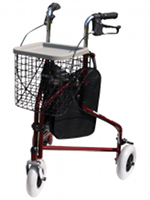
A 3 wheel walker is very similar to a rollator walker except it only has 3 wheels (instead of the 4 wheeled rollator walker) and does not have a seat.
They work well both indoors and outdoors but are not as stable as rollator walkers for elderly due to one less wheel.
Who Should Use A 3 Wheel Walker?
Elderly who have some balance, strength and endurance issues but do not need the added stability of other walkers such as a rollator walker.
If the senior is choosing between a 3 wheel walker and a rollator walker, many prefer the rollator because they have a built in seat.
Who Should NOT Use A 3 Wheel Walker?
Elderly who need more support than a 3 wheel walker can provide should consider other walkers such as a folding walker or rollator walker.
Elderly who need a seat should also consider a rollator.
Elderly who have significant problems walking may be better suited to using a wheelchair such as a light weight wheelchair.
How to Use a 3 Wheel Walker
A 3 wheel walker is used the same as a rollator walker (see above) except there is no seat to use.
It's important to adjust the walker so it fits properly and to always lock the brakes when getting up/down from a chair, couch or bed to prevent the walker from rolling away.
Recommended Features
A good 3 wheel walker will have:
- Large wheels - 8" in diameter or more so it rolls more easily over uneven ground.
- Lightweight - So it is easy to use.
- Easy to use brakes - Some brakes are too stiff for some elderly.
- Foldable - So it can easily fit in the trunk of a car.
- Basket/bag - To carry items.
Accessories
There are a number of walker accessories including:
- Cup holder - To carry a drink container.
- Cane holder - To securely carry a cane.
- Oxygen holder - To safely and securely carry an oxygen tank.
How Much Does a 3 Wheel Walker Cost?
3 wheel walkers cost $100-500 depending on quality and features.
For more information: 3 Wheel Walkers
U-step Walker
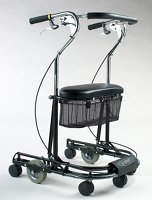
These are similar to rollator walkers for elderly except they are set up so the user has to squeeze the brake levers to release the brake (the walker stops if the brakes are released). It also has several smaller wheels rather than four larger wheels and is heavier which provides a more stable platform for the senior to hold onto.
Who Should Use a U-step Walker?
Elderly with neurological conditions who need a very stable device. For example, seniors with Parkinson's disease prefer this style.
Elderly who will benefit from being able to slow the walker down as the U-Step has a tension adjustment.
Who Should NOT Use a U-step Walker?
They are not very useful outside as the small wheels do not roll easily over uneven ground.
Elderly that just need assistance/support with balance, strength and endurance should consider rollator walkers for elderly.
How to Use a U-Step Walker
- Adjust to proper height - See below for how to fit a walker
- Get in position - Place both hands on the handles
- Stand upright - This will place the senior within the walker with their feet in line with the rear wheels.
- Unlock brakes - The wheels on this type of walker are always locked until the brake levers are squeezed.
- Walk into the walker - Try to stay in a normal upright walking position and not to hunch over or get the walker to far ahead.
- Small steps - Take small steps especially while turning around - for example to turn around to get into a chair.
- Using seat - Find level ground, release brake levers (to lock brakes), turn around and sit down.
Recommended Features
- Standard features These walkers include a bag/basket and seat.
- Indoor or smoothed surface use - They work well inside and on smooth surfaces (inside a mall) as the wheels are small.
Walker Accessories
- Laser feature - The laser draws a line in front of the users feet so that they can step over it - this can help elderly with Parkinson's Disease who have difficulty initiating movements.
- Oxygen tank holder - Some smaller oxygen tanks and portable concentrators can fit in the basket/bag of the walker. Other tanks will need a holder to secure it to the walker. Keep the weight low to the ground so that it doesn't make the walker top heavy and prone to tipping over.
How Much Does a U-Step Walker Cost?
A U-Step walker will cost $550-700.
Knee Walker
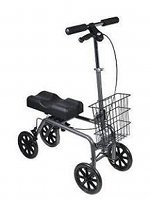
A knee walker is designed for elderly who need to keep weight off a leg or foot due to a fracture or surgery.
It is a good alternative to crutches for elderly who have good balance, strength and endurance as it is easier to use than crutches.
Who Should Use a Knee Walker?
These types of walkers for elderly are designed for seniors with good balance, strength and endurance who need to keep their weight off one leg/foot - common after a fracture or surgery.
Who Should NOT Use a Knee Walker?
Elderly who do not have good balance and need to keep weight off a leg/foot should consider using a folding walker and/or a light weight wheelchair.
Elderly who need a walker for support (and not to keep weight off a leg/foot) because they have balance, strength and endurance issues would be better off considering other wheeled walkers for elderly.
How to Use a Knee Walker
A knee walker works much like a kid's scooter. The senior places their sore/affected/injured leg on the leg support, holds onto the handlebars and pushes with their good leg.
It takes a certain level of balance, coordination, strength and endurance to safely use a knee walker.
As with all walkers for elderly, always practice on level ground and at slow speeds when beginning to use one.
Recommended Features
A good knee walker will have:
- Height adjustable - To ensure a proper fit.
- Padded leg support - For comfort.
- Hand brakes - For control.
- Steerable - Easier to use than fixed knee walkers which need to be lifted to turn.
How Much Does a Knee Walker Cost?
A knee walker costs $350-500 depending on the quality and features.
For more information: Knee Walker
How to Fit a Walker
The general guideline for fitting walkers for elderly is that the handles are at the same height as the senior's wrist (when their arms are at their side).
- Proper position - Have the senior stand with their arm at their side - you may need to be standing near a table or wall so they can balance themselves.
- Measure - Measure from the crease of their wrist to the ground - wearing their normal shoes for in the house or outside.
- Lift to assess weight - Make sure the walker is light enough that the senior can move the walker themselves. If they plan to take it in a car, make sure they (or their spouse or whoever is driving) can fold the walker and put it in the car.
- Compare measurements of senior to walker specifications - Find the measurements of the handle heights of the walker and the seat heights (if applicable). You should only consider walkers that can be adjusted so that the walker handle height is close to the crease of the wrist of the user.
- For rollators - Measure from the crease of the knee to the ground - this will help in deciding on seat height (if the walker model has different seat heights - not all do)
- For rollators - Make sure the senior can operate the brakes as some models are very stiff. This can be especially difficult for seniors with arthritis in their hands.
- Demo/Test - Whenever possible, try different styles/models of the walker type you are interested in buying. It is like buying a car, there are cheap versions and luxury versions. I always recommend purchasing a high quality walker as they are more stable, you can repair/replace parts and seniors find them easier and safer to use.
How to Convince Elderly to Use a Walker
It's important to note that it's common for elderly to be reluctant in using walkers for elderly. It takes some time to get used to - sometimes even months - before they will begin to see the benefits of using one.
- Consider how they may feel - Many seniors are reluctant to use walkers for elderly because they feel it signifies a loss of independence, a sign of aging and frailty, etc.
- Discuss the benefits of using walkers for elderly - Prevent falls, improve confidence, feel more secure, overcome fear of falling, can carry items easily and can sit down and rest (for rollators).
- Discuss the consequences of not using walkers for elderly - Falling and hurting themselves. The more serious injuries are wrist, hip, pelvis and clavicle (collarbone) fractures. These can permanently change a senior's ability to safely and comfortably walk. It can also involve surgery and months of rehabilitation therapy.
- Discuss how you feel - That you are worried they will fall and injury themselves if they do not use walkers for elderly.
- Patience - Give your parents some time to adjust to the idea of using walkers for elderly. They are entitled to make their own decisions and live at risk of falling.
Return to Mobility Products for the Elderly
Return to Caring for Aging Parents


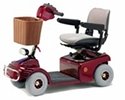



New! Comments
Have your say about what you just read! Leave me a comment in the box below.